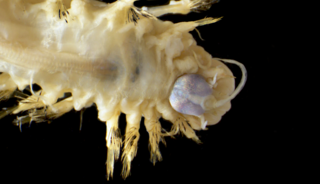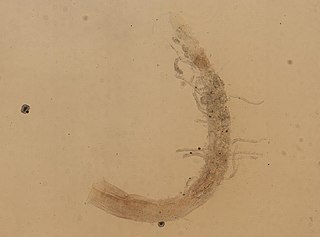
Eunoe abyssorum is a scale worm first described in 1885. The type locality is in the Great Australian Bight, which is south of mainland Australia.
Eunoe eura is a scale worm described from off Peru in the South Pacific Ocean at a depth of 550 m.
Eunoe hozawai is a scale worm described from Japan, North Pacific Ocean.

Acanthicolepis is a genus of marine annelids in the family Polynoidae. The genus was described in 1990 and includes two short-bodied species with up to 50 segments and which occur in the Mediterranean Sea and North-east Atlantic Ocean.
Eunoe iphionoides is a scale worm known from the South Pacific Ocean off New Zealand at depths of 549–3817m.
Eunoe opalina is a scale worm widely distributed in the Southern Ocean at depths of about 200–1400m.
Eunoe yedoensis is a scale worm described from off Japan in the North Pacific Ocean at a depth of 641 m.
Australaugeneria michaelseni is a scale worm known from northern Australia and Papua New Guinea from depths of 30m or less.
Australaugeneria rutilans is a scale worm known from northern Australia, south-east Asia and the Persian Gulf, from depths of 28m or less.
Eunoe nodosa is a scale worm which is widely distributed in the Arctic Ocean, North Atlantic Ocean and North Pacific Ocean from shallow waters to depths of about 1250m.

Eunoe oerstedi is a scale worm which is widely distributed in the Arctic Ocean, North Atlantic Ocean and North Pacific Ocean from shallow waters to depths of about 950m.
Eunoe spinulosa is a scale worm described from the North Atlantic Ocean off Nova Scotia.
Eunoe tritoni is a scale worm described from the Færö Channel in the North Atlantic Ocean.
Eunoe tuerkayi is a scale worm described from the Mediterranean Sea at depths of about 30m.
Admetella longipedata is a scale worm that occurs widely in the Indian, Pacific and Atlantic Oceans at depths of 400–6,000m.
Antipathipolyeunoa is a genus of marine annelids in the family Polynoidae. The genus contains a single species, Antipathipolyeunoa nuttingi, found in the Caribbean Sea at a depth of 91 metres.
Austropolaria is a genus of marine annelids in the family Polynoidae. The genus includes a single species, Austropolaria magnicirrata, which is known only from the Amundsen Sea in the Southern Ocean, at depths of 1000 to 1500m.
Parahololepidella is a genus of marine annelids in the family Polynoidae. The genus contains a single species, Parahololepidella greeffi, This species is known from the east equatorial Atlantic Ocean and Cape Verde Islands at a maximum depth of 30m.
Polyeunoa is a genus of marine annelids in the family Polynoidae. The genus contains a two species, with only P. laevis being widespread and abundant in the Southern Ocean.
Polyeunoa maculata is a scale worm which is only known from Ratnagiri, India


